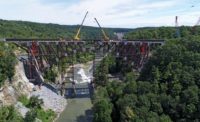PROJECT COST: $390 Million
Construction of a new $390 million Moses Wheeler Bridge, which carries I-95 over the Housatonic River between the Connecticut towns of Stratford and Milford, is moving ahead after general contractor, Torrington, CT-based O&G Industries started work last September on the first of a two-phase project. The planned 14-span structure, replacing the original bridge from the mid-1950s, is expected to take six years to complete with a 2016 finish date.

The contract for phase two, which includes construction of the actual 3,200-ft. superstructure, will be advertised next September. It will be bid with steel and segmental concrete design alternates.
The project comes with a number of challenges, says Robert Yirigian, Associate Vice President with HNTB Corporation, the prime consulting firm providing construction engineering and inspection service on the project on behalf of ConnDOT, the owner of the project. The bridge carries more than 110,000 vehicles per day along I-95, one of the busiest highways in the Northeast corridor. The route will remain opened during construction, but because the new bridge will occupy the same footprint and centerline of the existing one, site access for materials, as well as construction, will require careful orchestration.
State DEP permitting restrictions, intended to protect sensitive sea life in the river, also complicate construction scheduling, says Yirigian.
For now, however, crews are concentrating on the first phase; building supporting structures for 13 concrete piers anchored in solid rock. Each pier consists of three individual concrete columns which will eventually be joined by 14 horizontal spans to form the bridge superstructure.
Under the first phase $51 million contract, 35 ten-foot diameter drilled shaft foundations are being constructed, as well as related site and utility work. O&G is also constructing trestles in the river for use by the phase two contractor for erection of the bridge. The schedule calls for completion of the phase one contract next year.
Noteworthy, says Yirigian is that "the drill shafts are the largest ones ever drilled in Connecticut."
Since the original bridge was built in the 1950s, both sides of land have seen development, thus limiting the workspace. And because the new structure will share the same centerline as the existing bridge, Yirigian says, "the big challenge will be maintaining traffic on one of the busiest roads in the Northeast."
The second phase will be divided into three construction stages: construction of the outer southbound lanes of I-95; construction of the outer northbound lanes; and the construction of a center portion that will provide transverse continuity and additional lanes for both the northbound and southbound direction of I-95. The new bridge, which will be widened to four lanes in each direction, will include full shoulders on both sides, something virtually non-existent on the old bridge.
Key Players
Owner: ConnDOT
General Contractor: O & G Industries, Torrington, Conn.
Construction Manager (CEI): HNTB Corp., Rocky Hill, Conn.
Drilled Shaft Subcontractor: Raito Inc., Woburn, Mass.
Civil/Structural Engineer: STV Inc, Stratford, Conn.



